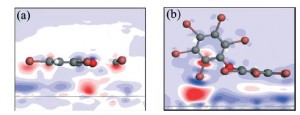Graphene nanomaterials have the potential to act as surfaces to rapidly extract persistent organic molecules such as PBDEs, therefore providing potential use in analytical and environmental chemistry applications, according to a new study by Ding and co-workers at Hong Kong University.
Polybrominated diphenyl ethers (PBDEs) are a class of organic compounds widely used as flame retardants in electrical equipment, furniture and textiles. PBDEs are of concern due to possible adverse health effects, including potential toxic and endocrine disrupting behaviour. This has led to the phasing out of their production, import and sale in many countries. However, PBDEs can migrate from existing products and are shown to bioaccumulate in the human body. Therefore, it is essential to find ways to monitor their levels in the environment in order to understand and minimize human exposure, and to develop methods to efficiently remove them from the environment.
Treatment methods for PBDEs have not yet been fully developed for any environmental medium. Recently, however, the low dimensional nanomaterial graphene has emerged as a potentially useful substance in this field. The large surface area to volume ratio, unique chemical and thermal stability and high adsorption capacity of graphene make it suitable for possible use as an adsorbent material for extraction, removal, sensing and degradation of pollutant molecules including aromatic organic compounds like PBDEs. It is important therefore to fully understand the adsorption behaviour of organic pollutants on graphene surfaces to optimise its potential usefulness.
The study by Ding and co workers provides a theoretical investigation of the mechanisms, properties and thermodynamics underlying the adsorption of PBDEs on graphene surfaces. These computer simulations are a preferred way to study this adsorption behaviour, providing a relatively cheap method of obtaining fundamental information that avoids the limitations of using experimental laboratory studies. This is the first study of its kind to attempt this approach.
The method involved investigating adsorption mechanisms of nine PBDEs and DE on graphene in an aqueous environment using density functional theory (DFT) and molecular dynamics (MD) methods. The approach employed both local density approximation (LDA) and generalized gradient approximation (GGA) with the DFT method, corrected to take into account dispersive forces. MD simulations were carried out to supplement the DFT calculations using the COMPASS force field.
The results indicate the adsorption of PBDEs to graphene is very fast, confirming the remarkable performance of graphene in this extraction process. Electronic density of states, charge transfer analysis, and thermodynamic analysis indicate that PBDE adsorption to graphene is primarily controlled by physiosoption. It was shown that interaction strengths between PBDEs and graphene increased with the degree of bromination, due to relatively strong interactions between bromine atoms and the graphene surface.
For compounds without ortho-substitution, adsorption energies exhibited a positive linear correlation between interaction strength of PBDEs and DEs with compound hydrophobicity, while PBDEs with ortho-substitution displayed different adsorption behaviour influenced by steric hindrance. However, adsorption is not simply controlled by the hydrophobicity of the adsorbate. The authors indicate that π-π interactions play a more important role in the PBDE adsorption system and confirm that van der Waals interactions are a dominant factor governing the π-π stacking behaviour.
This study enhances our understanding of adsorption chemistry of aromatic organic pollutants on graphene nanomaterials. This knowledge will help open up the potential use of these materials in analytical and environmental chemistry applications. Therefore, this paper will be of interest to researchers in these broad fields, particularly those interested in laboratory extraction procedures, wastewater treatment processes and contaminated land remediation.
Click on the link below to download your copy of this newly published paper – and remember – it’s FREE TO ACCESS with an RSC publishing account!
Interactions between polybrominated diphenyl ethers and graphene surface: a DFT and MD investigation, Ning Ding, Xiangfeng Chen, and Chi-Man Lawrence Wu. DOI: 10.1039/c3en00037k











